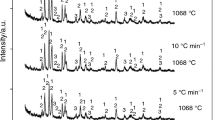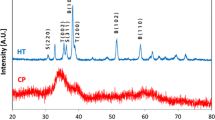Abstract
The structural and thermal properties of sodium niobium phosphate glass are studied to analyse its suitability for immobilizing long-lived radioactive waste from nuclear reprocessing plants. Two series of sodium niobium phosphate glasses such as (A) xNb2O5–(50−x)Na2O–50P2O5 and (B) xNb2O5–(50−x/2)Na2O–(50−x/2) P2O5 (x = 0, 10, 20, 30, 40 mol.%) are prepared by the conventional melt–quenching technique. The influence of the incremental addition of Nb2O5 on the structural and thermal properties of the above two series is investigated. The FTIR and Raman spectra of these glasses revealed that the number of [NbO6] octahedral chain increases with Nb content and dominates as the major structural unit over the number of PO4 tetrahedra unit. The glass transition temperature (Tg), crystallization temperature (Tc) and melting temperature (Tm) are measured by using a differential scanning calorimeter (DSC). Other thermal stability parameters such as Hruby (KH), Angell (KA), Saad–Poulain (KSP) and Weinberg (KW), the total relaxation time of transformation and fragility are evaluated and compared between different composition of glasses. For both series A and B, the glass transition temperature increases with Nb content, suggesting the formation of a larger number of P–O–Nb or Nb–O–Nb linkages compared to the PO4 tetrahedra, resulting in a more rigid network. This is confirmed by Raman spectra which show an increase in the number of Nb–O–Nb bonds with Nb content. The major crystalline phases formed by devitrifying these glasses are identified by XRD and are found to be mainly NaPO3, NbOPO4, Na2Nb6P4O26 and Na4Nb8P4O32.


















Similar content being viewed by others
References
Costa-Silva D, Silva A, Mello-Castanho S, Rambo C, (2019) Niobium modified glass for nuclear waste immobilization. In: Proceedings of the INAC 2019: international nuclear Atlantic conference. Nuclear new horizons: fueling our future
DeWees R, Wang H. Synthesis and properties of NaSICON-type LATP and LAGP solid electrolytes. Chemsuschem. 2019;12(16):3713–25.
Kuwik M, Pisarska J, Pisarski WA. Influence of oxide glass modifiers on the structural and spectroscopic properties of phosphate glasses for visible and near-infrared photonic applications. Materials. 2020;13(21):4746.
Christie JK, Ainsworth RI, Di Tommaso D, de Leeuw NH. Nanoscale chains control the solubility of phosphate glasses for biomedical applications. J Phys Chem B. 2013;117(36):10652–7.
Basavapoornima C, Kesavulu C, Maheswari T, Pecharapa W, Depuru SR, Jayasankar C. Spectral characteristics of Pr3+-doped lead based phosphate glasses for optical display device applications. J Lumin. 2020;228: 117585.
Ahmed I, Lewis M, Olsen I, Knowles J. Phosphate glasses for tissue engineering: Part 1. Processing and characterisation of a ternary-based P2O5–CaO–Na2O glass system. Biomaterials. 2004;25(3):491–9.
Sene F, Martinelli J, Gomes L. Synthesis and characterization of niobium phosphate glasses containing barium and potassium. J Non-Cryst Solids. 2004;348:30–7.
Khor S, Talib Z, Yunus WM. Optical properties of ternary zinc magnesium phosphate glasses. Ceram Int. 2012;38(2):935–40.
Zhou Y, Zheng H, Zhao S, Zhang C, Bai W, Sun C, et al. Preparation, structural and mechanical characterization of ceria-added phosphate glasses. J Non-Cryst Solids. 2021;570: 120878.
Ali A, Singh S, Pyare R. SrO assisted 1393 glass scaffold with enhanced biological compatibility. J Non-Cryst Solids. 2020;550: 120392.
Donato M, Gagliardi M, Sirleto L, Messina G, Lipovskii A, Tagantsev D, et al. Raman optical amplification properties of sodium–niobium–phosphate glasses. Appl Phys Lett. 2010;97(23): 231111.
Sirleto L, Donato M, Messina G, Santangelo S, Lipovskii A, Tagantsev D, et al. Raman gain in niobium-phosphate glasses. Appl Phys Lett. 2009;94(3): 031105.
Hardcastle FD, Wachs IE. Determination of niobium-oxygen bond distances and bond orders by Raman spectroscopy. Solid State Ionics. 1991;45(3–4):201–13.
Chu C, Wu J, Yung S, Chin T, Zhang T, Wu F. Optical and structural properties of Sr–Nb–phosphate glasses. J Non-Cryst Solids. 2011;357(3):939–45.
Lee Y-M, Hsu S, Yung S, Zhang T, Huang Y, Wu J, et al. Structural characterizations and optical properties of new Li–Sr–Nb-phosphate glasses. Mater Chem Phys. 2014;144(3):235–41.
Ravangave L, Devde G. Structure and physical properties of 59B2O3–10Na2O–(30–x) CdO–xZnO–1CuO (0≤ x≤ 30) glass system. Adv Glass Sci Technol. 2018;1:21–38.
Upender G, Prasad M. Raman, FTIR, thermal and optical properties of TeO2-Nb2O5-B2O3-V2O5 quaternary glass system. J Taibah Univ Sci. 2017;11(4):583–92.
Stoch P, Ciecinska M, Stoch A. Thermal properties of phosphate glasses for salt waste immobilization. J Therm Anal Calorim. 2014;117(1):197–204.
Hrubý A. Evaluation of glass-forming tendency by means of DTA. Czechoslovak J Phys B. 1972;22(11):1187–93.
Nascimento ML, Souza LA, Ferreira EB, Zanotto ED. Can glass stability parameters infer glass forming ability? J Non-Cryst Solids. 2005;351(40–42):3296–308.
Rathore K, Saxena N. Kinetics of glass transition and thermal stability of Se 58 Ge 42–x Pb x (9≤ x≤ 20) glasses. Appl Phys A. 2010;98(2):441–8.
Zhang G, Friot B, Poulain M. New gallium and indium based fluoride glasses. J Non-Cryst Solids. 1997;213:6–10.
Weinberg M. Assessment of glass stability criteria. Phys Chem Glasses. 1994;35(3):119–23.
Guo J, Zu F-Q, Chen Z-H, Li X-F, Xi Y, Shen R-R, et al. Attempt to depict glass forming ability of bulk metallic glasses using the criterion of the total relaxation time at the glass transition. J Non-Cryst Solids. 2006;352(36–37):3859–63.
Soliman A, Kashif I. Copper oxide content dependence of crystallization behavior, glass forming ability, glass stability and fragility of lithium borate glasses. Physica B. 2010;405(1):247–53.
Kodama M, Kojima S. Anharmonicity and fragility in lithium borate glasses. J Therm Anal Calorim. 2002;69(3):961–70.
Hudgens JJ, Brow RK, Tallant DR, Martin SW. Raman spectroscopy study of the structure of lithium and sodium ultraphosphate glasses. J Non-Cryst Solids. 1998;223(1–2):21–31.
Benyounoussy S, Bih L, Muñoz F, Rubio-Marcos F, Naji M, El Bouari A. Structure, dielectric, and energy storage behaviors of the lossy glass-ceramics obtained from Na2O-Nb2O5-P2O5 glassy-system. Phase Transitions. 2021;94(9):634–50.
Brow RK, Tallant DR, Myers ST, Phifer CC. The short-range structure of zinc polyphosphate glass. J Non-Cryst Solids. 1995;191(1–2):45–55.
Hsu S, Wu J, Yung S, Chin T, Zhang T, Lee Y, et al. Evaluation of chemical durability, thermal properties and structure characteristics of Nb–Sr-phosphate glasses by Raman and NMR spectroscopy. J Non-Cryst Solids. 2012;358(1):14–9.
Griebenow K, Bragatto CB, Kamitsos EI, Wondraczek L. Mixed-modifier effect in alkaline earth metaphosphate glasses. J Non-Cryst Solids. 2018;481:447–56.
Brow RK. Review: the structure of simple phosphate glasses. J Non-Crystal Solids. 2000;263:1–28.
Flambard A, Videau J-J, Delevoye L, Cardinal T, Labrugère C, Rivero C, et al. Structure and nonlinear optical properties of sodium–niobium phosphate glasses. J Non-Cryst Solids. 2008;354(30):3540–7.
Benyounoussy S, Bih L, Muñoz F, Rubio-Marcos F, Bouari AE. Effect of the Na2O–Nb2O5–P2O5 glass additive on the structure, dielectric and energy storage performances of sodium niobate ceramics. Heliyon. 2021;7(5): e07113.
De Araujo E, De Paiva J, Freitas J Jr, Sombra A. Raman and infrared spectroscopy studies of LiNbO3 in niobate glass-ceramics. J Phys Chem Solids. 1998;59(5):689–94.
Costentin G, Borel MM, Grandin A, Leclaire A, Raveau B. Phosphate niobium bronzes and bronzoids with the MPTBp structure: Na4Nb8P4O32 and Na4− xAxNb7MP4O32 fourth members of the series Ax (PO2)4 (NbO3) 2m. Mater Res Bull. 1991;26(10):1051–7.
Stunda A, Mironova-Ulmane N, Borodajenko N, Berzina-Cimdina L. Phase transition in niobophosphate glass-ceramic. Adv Mater Res. 2011;222:259–62.
Bih L, Azrour M, Manoun B, Graça M, Valente M. Raman spectroscopy, x-ray, SEM, and DTA analysis of alkali-phosphate glasses containing and Nb2O5. J Spectroscopy. 2013.
Ol’shin P, Povolotskii A, Man’shina A, Markov V, Sokolov I. Optic properties of niobium-phosphate glasses containing lithium, sodium, and potassium oxides. Glass Phys Chem. 2017;43(4):294–7.
Sirleto L, Donato MG, Messina G, Santangelo S, Lipovskii AA, Tagantsev DK, et al. (eds). Enhanced Raman gain coefficients and bandwidths of sodium-niobium-phosphate glasses for Raman gain media. In: CLEO/Europe - EQEC 2009 - European conference on lasers and electro-optics and the European quantum electronics conference, 14–19 June; 2009.
Holubová J, Černošek Z, Hejda P. The influence of niobium on the structure of Nb2O5–ZnO–P2O5 glasses. J Non Cryst Solids. 2018;502:35–43. https://doi.org/10.1016/j.jnoncrysol.2018.10.020.
Zhang L, Brow RK. A Raman study of iron–phosphate crystalline compounds and glasses. J Am Ceram Soc. 2011;94(9):3123–30.
Acknowledgements
The authors are grateful to Dr. N. Sivaraman, Director, MC&MFCG, and Dr. V. Jayaraman, Associate Director, FMCG, IGCAR, for their support and encouragement. Dr. Kitheri Joseph, AD, MFRG, is thankfully acknowledged for support and encouragement. The authors are very much thankful to Mr. Dasarath Maji/AFSS for providing facility for recording thermogram of the samples and Mr. Swaroop Chandra for recording the FTIR. The authors are very much thankful to Dr. Pradyumna Kumar Parida, MMG, IGCAR, for analysing the samples by EDS.
Author information
Authors and Affiliations
Contributions
AS was responsible for sample preparation, experimental work, conceptualization, interpretation of results, formal analysis and writing the original draft. SKB was involved in experimental work, data collection and interpretation. RVK and HJ took part in discussion, reviewing and editing. SC participated in Raman data collection and interpretation.
Corresponding authors
Ethics declarations
Conflict of interest
The authors hereby declare that the work reported in this article is original and has not been published elsewhere. There is no conflict of interest on this reported work among the authors or with any other body.
Additional information
Publisher's Note
Springer Nature remains neutral with regard to jurisdictional claims in published maps and institutional affiliations.
Rights and permissions
Springer Nature or its licensor (e.g. a society or other partner) holds exclusive rights to this article under a publishing agreement with the author(s) or other rightsholder(s); author self-archiving of the accepted manuscript version of this article is solely governed by the terms of such publishing agreement and applicable law.
About this article
Cite this article
Senapati, A., Barik, S.K., Venkata Krishnan, R. et al. Studies on synthesis, structural and thermal properties of sodium niobium phosphate glasses for nuclear waste immobilization applications. J Therm Anal Calorim 148, 355–369 (2023). https://doi.org/10.1007/s10973-022-11760-3
Received:
Accepted:
Published:
Issue Date:
DOI: https://doi.org/10.1007/s10973-022-11760-3




